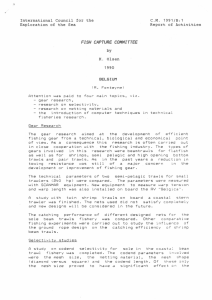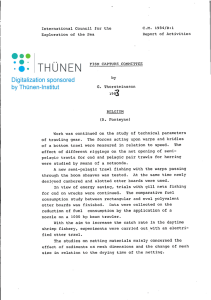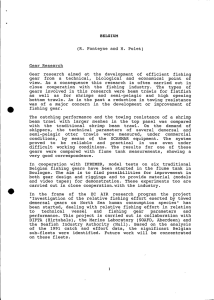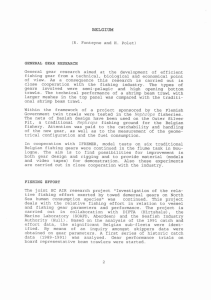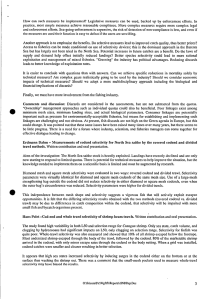(R. Fonteyne) - gear research, - selectivity research and
advertisement
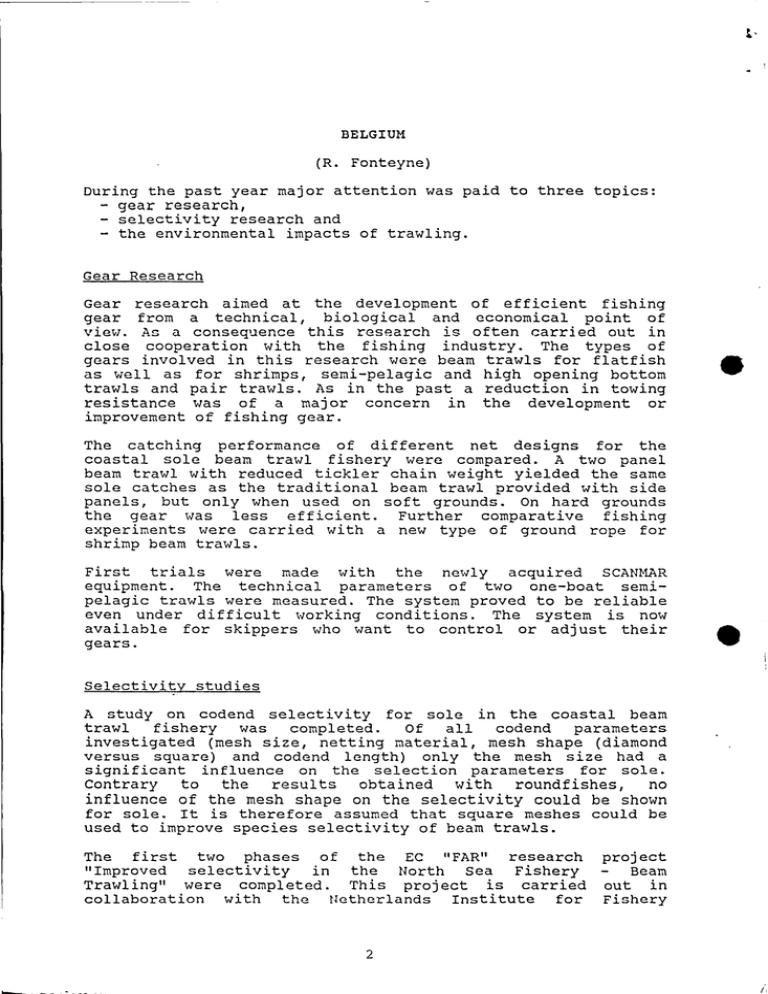
BELGIUM (R. Fonteyne) During the past year major attention was paid to three topics: - gear research, - selectivity research and - the environmental impacts of trawling. Gear Research Gear research aimed at the development of efficient fishing gear from a technical, biological and economical point of view. As a consequence this research is often carried out in close cooperation with the fishing industry. The types of gears involved in this research were beam trawls for flatfish as weIl as for shrimps, semi-pelagic and high opening bottom trawls and pair trawls. As in the past a reduction in towing resistance was of a major concern in the development or improvement of fishing gear. The catching performance of different net designs for the coastal sole beam trawl fishery were compared. A two panel beam trawl with reduced tickler chain weight yielded the same sole catches as the traditional beam trawl provided with side panels, but only when used on soft grounds. On hard grounds the gear was less efficient. Further comparative fishing experiments were carried with a new type of ground rope for shrimp beam trawls. First trials were made with the newly acquired SCAN~ßR equipment. The technical parameters of two one-boat semipelagic trawls were measured. The system proved to be reliable even under difficul t Horking conditions. The system is now available for skippers who want to control or adjust their gears. Selectivi~y a ... studies A study on codend selectivity for sole in the coastal beam trawl fishery was completed. Of all codend parameters investigated (mesh size, netting material, mesh shape (diamond versus square) and codend length) only the mesh size had a significant influence on the selection parameters for sole. Contrary to the results obtained with roundfishes, no influence of the mesh shape on the selectivity could be shown for sole. It is therefore assumed that square meshes could be used to improve species selectivity of beam trawls. The first two phases of the EC "FAR" research 11 Improved selectivity in the North Sea Fishery Trawling" were completed. This project is carried collaboration with the Netherlands Institute for project Beam out in Fishery 2 /, Investigations (Ymuiden) and Seafish Technology (Hull). The aim of the project is the development of a species selective beam trawl, with special emphasis on a substantial decrease of young roundfish discards while maintaining the level of flatfish" catches. Apart froI:'l a detailed literature search on the sUbject, a comprehensive inquiry on the technical aspects of beaI:'l trawling has been carried out. Alternative "round" beam trawls (for use with chain mats) with a square mesh top panel, a reduced top panel, shortened lastridge ropes, a lowered headline or with a square mesh top panel codend were designed. Models of these trawls were constructed and tested in the Seafish flume tank. The designs considered by the other partners in the project involve the use of separator panels, a square mesh window in the bottom panel and large diamond and hexagonal meshes in" the top panel. The next phases of the project incluc1e the observation of the full sc;}le ge;}rs at sea and catch cornparisons. The study on the methodology of selectivity experiments was finished. The experiments examined sole and dab caught by beam trawls. Due to the absence of masking effects, as occurs with the covered codend method, the results obtained with the twin trawl method are more reliable. The application of a new statistical model, developed by Canadian researchers, made it possible to bypass the problems usually encountered when analyzing data froI:'l twin trawl selectivity experiments. Technical/ecological aspects of trawling. The EC FAR project "Environmental impact of bottom gears on benthic fauna in relation to natural resources management and protection of the North Sea" was started. This proj ect is carried out in collaboration with institutes from the Netherlands, Germany and the UK. The Fisheries Research station will concentrate on the technical aspects of the environmental impact of beam trawling. Measurements will include the pressure of the gearon the bottom, trawl marks on different bottom types and survival of animals that escaped through tha codend meshes and of"disc~rded animals. other activities. The study of the shrinking of netting materials was continued. Test were conducted on the shrinkage due to sediment absorption in "function of the tension on the netting material. "The inventory of net plans and rigging of gears in use in Belgium was continued. The data base of wrecks and obstacles on fishing grounds visited by Belgian trawlers was cornpleted. 3
